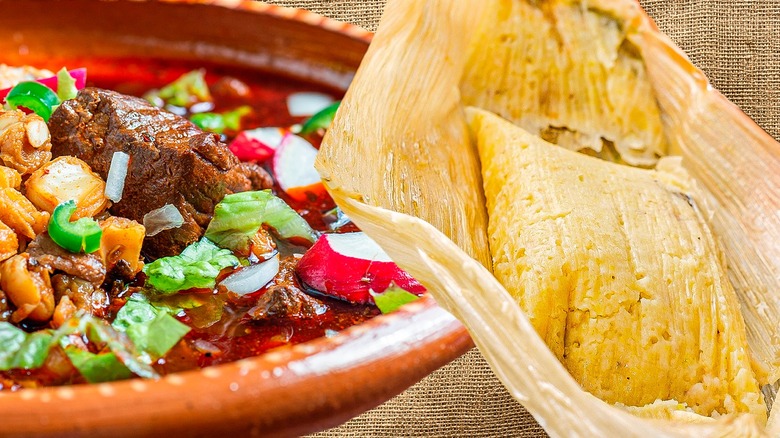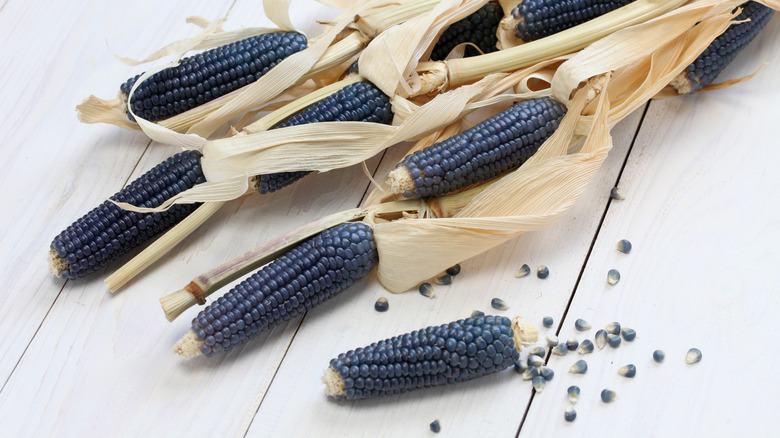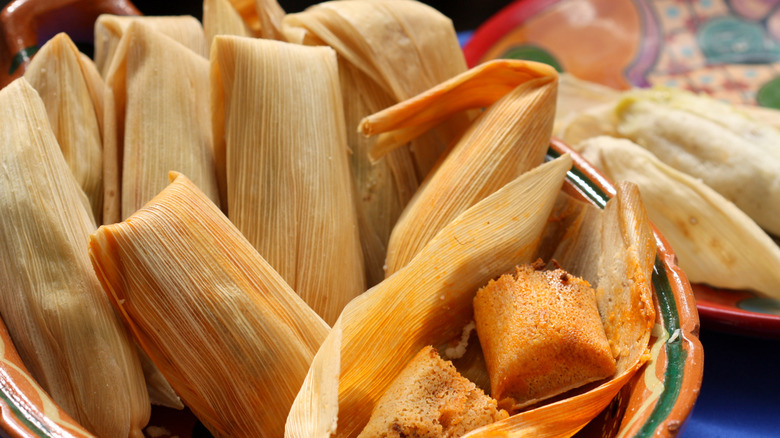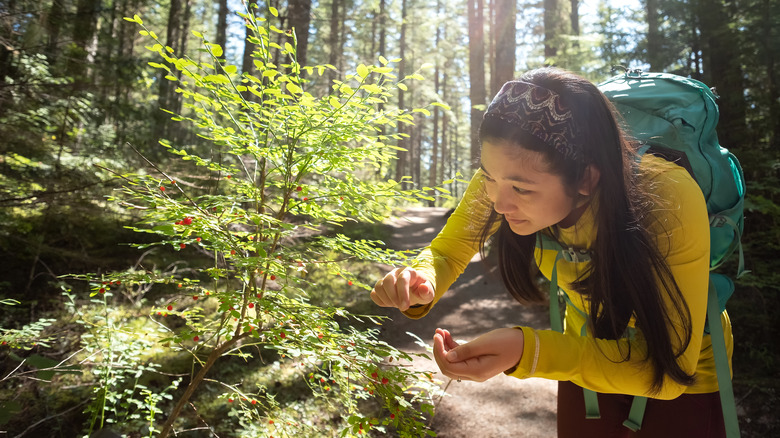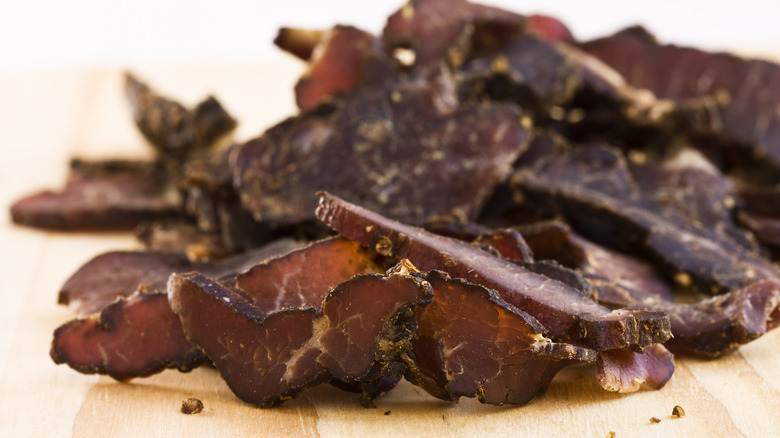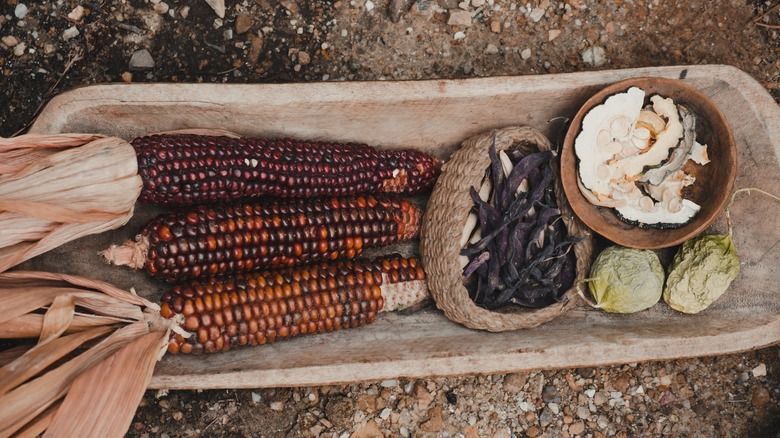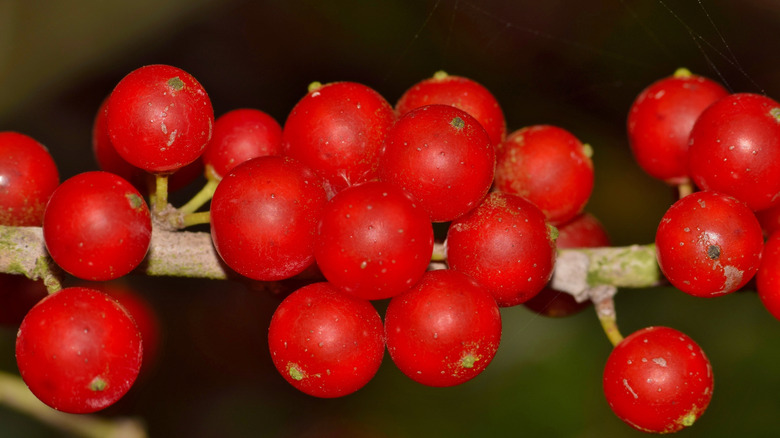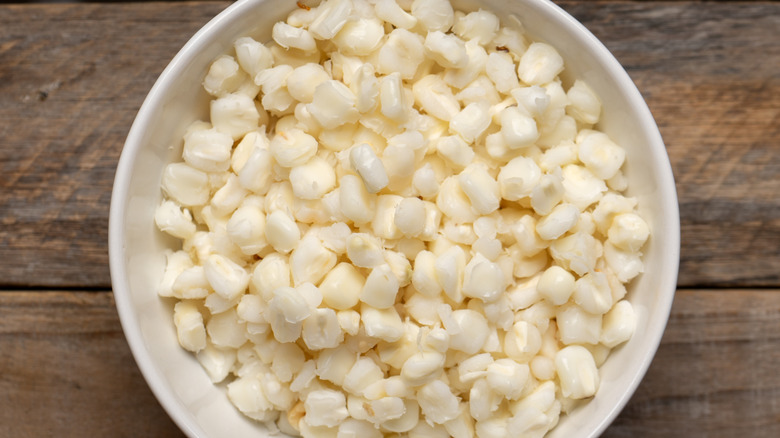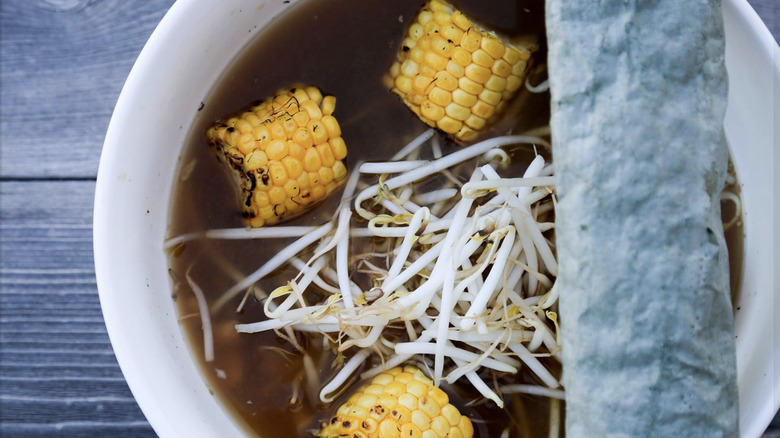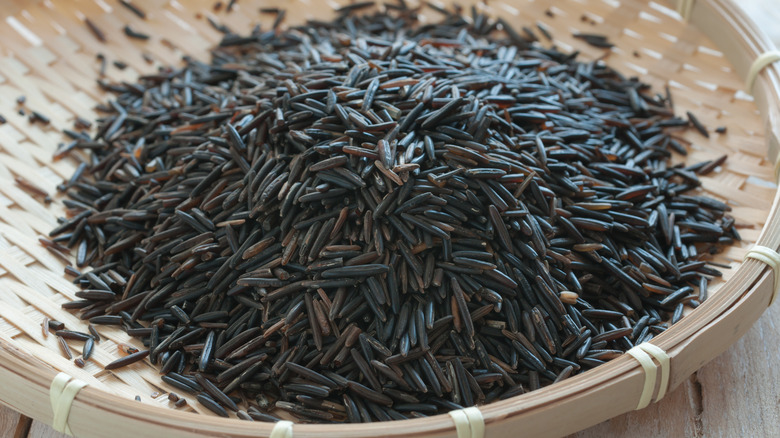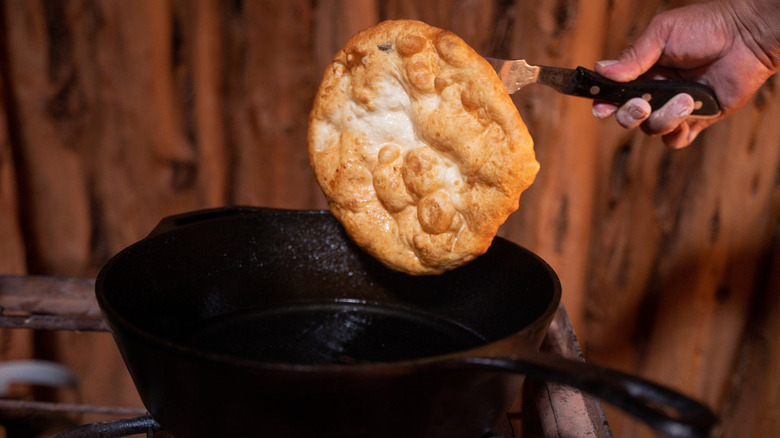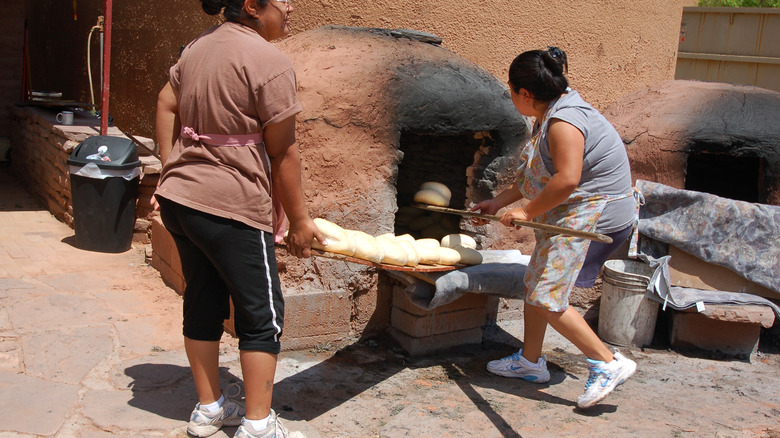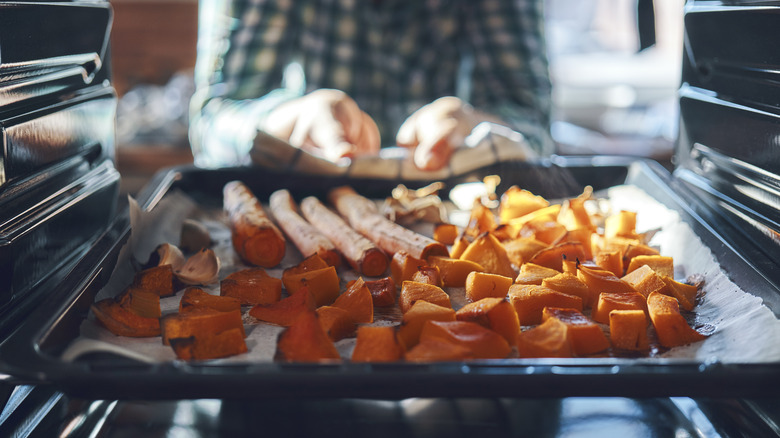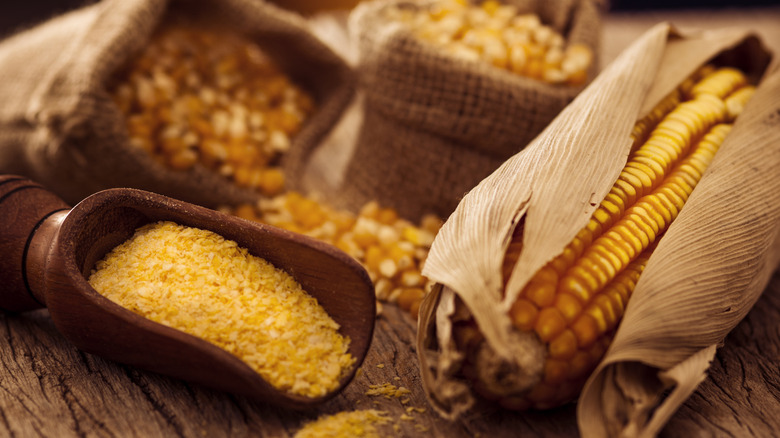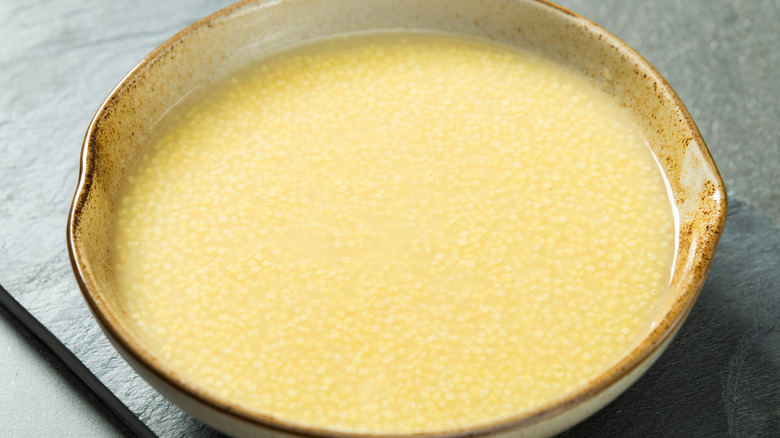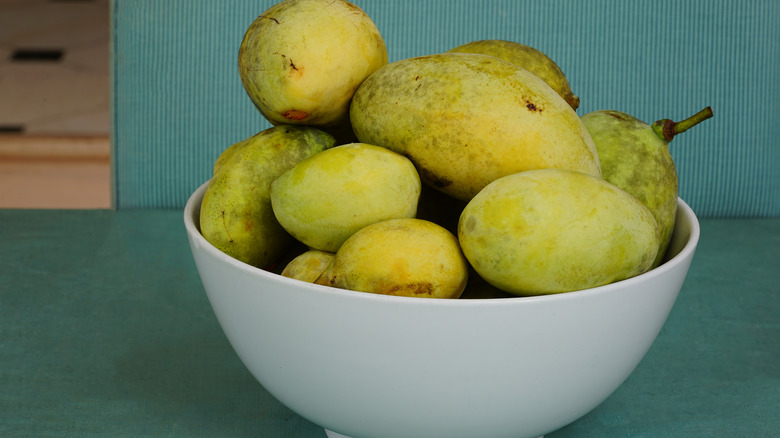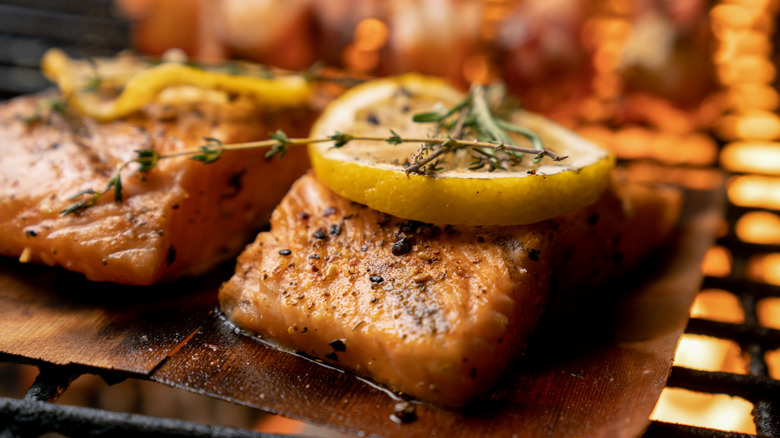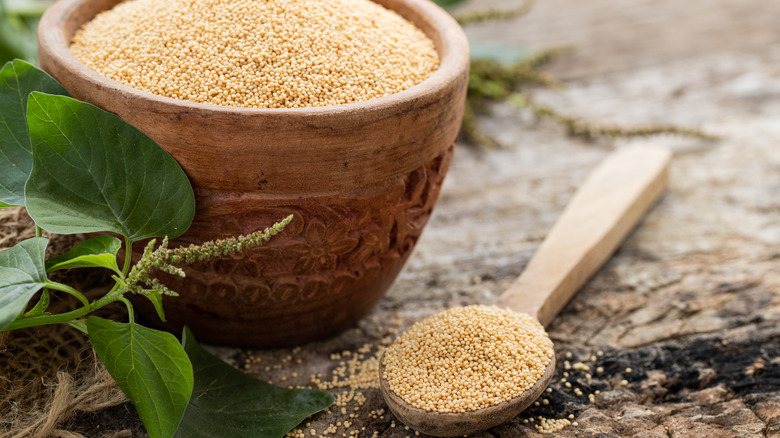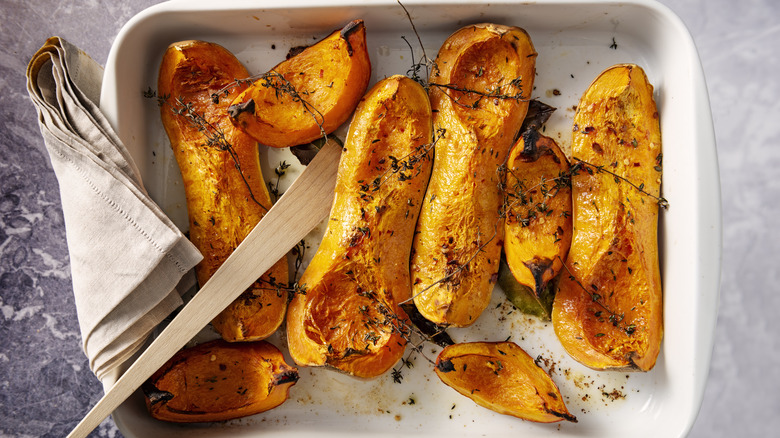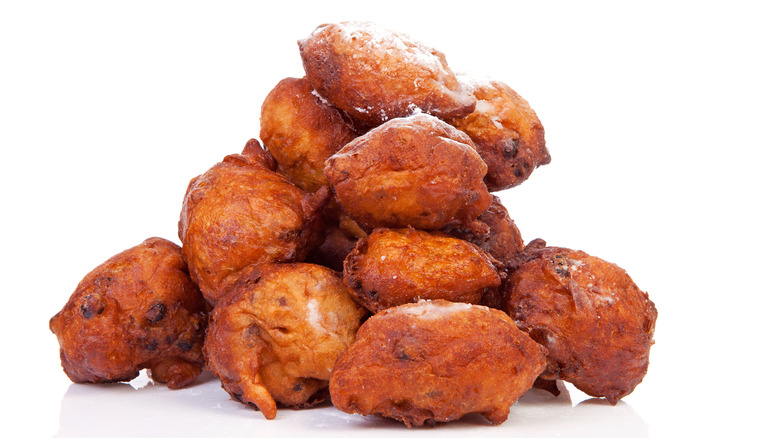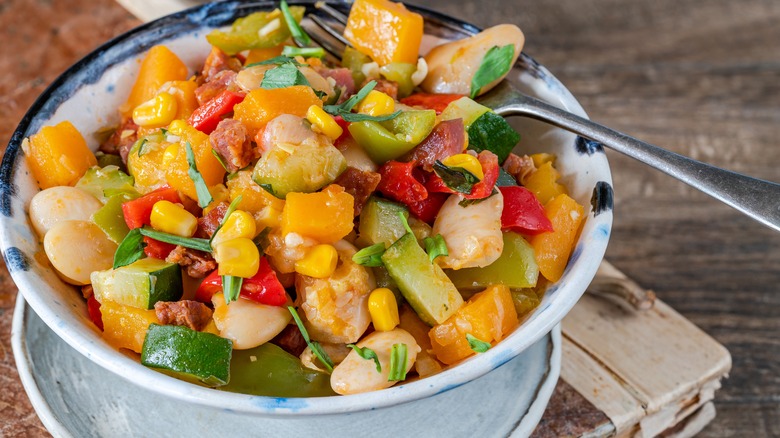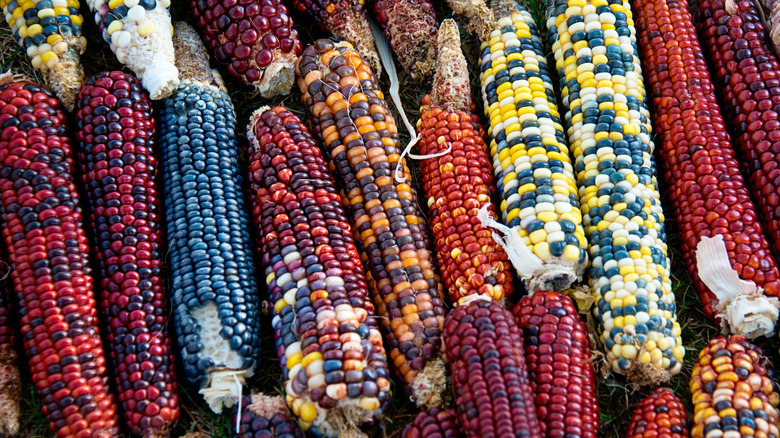21 Native American Foods You Should Try At Least Once
All too often, Native Americans and other Indigenous groups and cultures are written about in the past tense rather than in the present. While it is essential that the violent colonialism by the American government is acknowledged and understood, it is equally important to realize that these are not just cultures of the past but vibrant, resilient, and ever-modernizing and adapting cultures of the present and future.
Over the last twenty years or so, there has been a growing movement of Indigenous people within the culinary landscape who are working to showcase the ingredients and foodways the U.S. was built upon while also helping to increase access to Native foods within a wide variety of Native communities. Sustainable eating has long been a central value within Indigenous cuisines, such as regenerative agricultural practices like intercropping (aka growing several crops together) and using the whole plant or animal for waste-free cooking.
Here are just some of the delicious Native American dishes worth trying.
Blue Corn Mush
Corn is a staple food throughout many Indigenous communities in the U.S. and Mexico, with a sacred significance and being highly nutritious, especially when processed through nixtamalization. Though corn mush is eaten throughout many different Native American tribal communities, blue corn is unique to the southwest, originally grown by the Hopi community and enjoyed within many communities including the Hopi, Acoma, and Diné.
Blue corn mush, known as tanaashgiizh, is a comfort food with a creamy, grits or porridge-like texture sprinkled with juniper ash to create a calcium-rich food. This alternative to dairy is significant for a community that is known for being largely lactose intolerant, as dairy was not part of the native diet but one brought by the Spanish, alongside wheat and sugar.
Banahas
Banahas are described by Kansas City Magazine food writer Natalie Torres Gallagher as being "similar to tamales but without the filling," Choctaw bananas are cooked and consumed much in the same way as tamales. The cornmeal is mixed with water and the option of salt and baking soda before being wrapped in pre-softened corn husks and boiled until soft — approximately 30-45 minutes. The Choctaw Nation, considered to be the third largest nationally recognized Nation in the U.S., is located in the Southern regions of Oklahoma.
Unlike most tamales, traditional banahas are eaten just as is without meat or vegetable fillings. That said, no rule says you need to eat them plain to appreciate their Indigenous origins. Other options can include adding salsa, beans, or other flavorful garnishes. You can also slice each banaha into individual slivers and fry before serving.
Wojapi sauce
Like your favorite locally made jam, cranberry sauce, or compote, wojapi sauce consists of a mixture of cooked local and often wild berries. It's perfect for pouring over meats, game, corn-based dishes, and some vegetables to add tartness and acidity. Wojapi is a traditional food of the Lakota tribal community of South Dakota and uses local produce like chokecherries to create a rich purple-red sauce.
Chokecherries are just one ingredient used ceremonially, medicinally, and for culinary purposes within Indigenous cuisines, and they are known for their distinct tart flavor. They're also incredibly nutrient dense; chokecherries are high in antioxidants and vitamin C and have anti-inflammatory properties, making them a valuable ingredient in many aspects. Chokecherries grow well in various regions and are used amongst many Native communities in sauces like wojapi alongside tarts and puddings.
Wasna or pemmican
Dried meats are a staple product of many cultures around the globe. Jerkies, salt-cured meats, and similar products are so universal for many reasons, such as the seasonal availability of animals, long winters without plant-based foods, and the abundance of perishable meat needed to be preserved once an animal has been killed.
In Native American communities, wild animals like venison, bison, salmon, and turkey have been dried and preserved in such a manner. This includes wasna or pemmican, which are two different names for the same kind of food. Wasna is a term from the Lakota Sioux community and pemmican is used by the Cree.
Patties are made from dried game mixed with other locally sourced vegetation like ground chokecherries. The meat, whether using deer, elk, or bison is first dried and shredded, then mixed with the wild berries. Animal fat is used as a binding agent to create patties that pack a punch of energy and nutrition, plus are easy to eat while on the move.
Three Sisters
Though thoughts and ideas around sustainable agriculture have become hot topics (and necessary to adopt and support due to a rapidly changing climate), regenerative farming has always been a practice within Indigenous communities. Beans, squash, and corn are known as the Three Sisters because the trio is often grouped in Indigenous agriculture: The corn stalks provide natural support for which the beans can climb. The squash spreads out and protects the ground. Beans provide nitrogen to regenerate the soil for future crops. The Three Sisters highlight the benefit of centering eating and growing practices around environmental needs.
Not only do corn, beans, and squash grow to gather well, but they also pair well when cooking. Stews, salads, and even vegetarian burgers can be created by combining ingredients to form a delicious, adaptable, and nutritionally dense meal.
Yaupon tea
While there is much discussion around the tea from England and the coffee from Central and South America, the Indigenous source of caffeine in the U.S. was consumed long before either beverage made its way into our mugs. Cassina or Yaupon, as it's now called, gets its name from the Siouan language, Catawban. This caffeinated plant is indigenous to the U.S. and has been consumed as a strong tea by many Native American communities long before European contact.
Originally found wild in the South and Southeast areas of the country, the tea was believed to have been used in ceremonial rituals. A cousin of Yerba mate, it has a sweet-meets-herbaceous flavor. Though known for having originally been brewed to be a dark black liquid, it is now consumed more frequently as a gentler caffeinated beverage, sold loose leaf and in tea bags.
Hominy stew
Hominy is an ingredient popular in Indigenous as well as Mexican cooking traditions. Hominy, created from flint corn, is soaked and nixtamalized by being bathed in an alkaline mixture like lye, ash, or limestone to remove the outer layer of the kernels. If taken further in the rinsing process and ground, it becomes what we know to be masa.
Hominy is used in traditional Indigenous Mexican dishes like pozole and in similar stews within Native American traditions, some which have adapted to include non-Indigenous products like pork. It is often combined with some, if not all, of the three sisters. The stew also includes other foraged or Indigenous ingredients, including game and bitter greens like dandelion. The outcome is a hearty dish that reflects the local landscape.
Hopi piki bread
Hopi piki bread is made from dried Hopi blue corn and is traditionally a celebratory dish within the Hopi community. Blue corn is grown in the southwest, including Arizona where the Hopi Reservation is located. Piki dough comes from a mixture of finely ground blue cornmeal, juniper ash (a nutritious and calcium-rich component), and water before being spread thinly over a cooking stone and briefly grilled. The result is a paper-thin bread or flatbread of sorts that can be as delicate as it is labor-intensive.
Blue corn is significant to the Southwest region and to several other southwestern tribal communities and pueblos. Hopi use piki bread for celebratory dishes, wedding ceremonies, and rituals with spiritual significance, in addition to using blue corn as a daily food. Piki is unique to the Hopi community and its paper-thin, almost translucent texture takes dedication to the craft to execute well.
Manoomin
Manoomin is the Ojibwe name for the wild rice grown and harvested in the Great Lakes, home to the Anishinaabeg community. Manoomin is not actual rice but a long rice-like seed, which roughly translates to "good seed." It is considered "good" for various reasons, from its spiritual significance to its earthy flavor and dense nutritional value.
The wild seed is high in protein and fiber, amongst other things, making it an enriching as well as meaningful food. However, gathering and processing manoomin from the grasses of quiet, muddy-floored freshwater bodies like lakes is a complicated task and requires patience and dedication, according to Atlas Obscura. Thanks to various Indigenous-owned businesses and traders, manoomin can be found across the U.S. It is a pleasure to cook and eat in wild rice bowls, especially when accompanied by other Indigenous ingredients.
Fry bread or bannock
Fry bread and bannock, though often present at feast days and celebrations within Native American and First Nations communities, is a bread born out of conflict, displacement, and separation from culture. This complexity means people can have mixed feelings associated with the bread also called bannock.
Fry bread came from the Diné or Navajo community during a period known as Hwéeldi or The Long Walk. The U.S. government forcefully removed the tribe from their homelands and the displaced people survived on government rations of lard, flour, and sugar. This became the base of ingredients that we now know as fry bread. Eventually, the Diné were allowed to return to a portion of their land when the U.S. government realized the land and the rations were not sustainable. The bread went with them.
Today you can find fry bread and bannock topped with taco fillings at fairs as well as being sold on its own. Indigenous chefs like Shawn Adler have chosen to reclaim the food, while others like Sean Sherman have decided that it does not belong in their diet. No matter your stance, it is vital to recognize the bread's significance within U.S. history.
Pueblo bread
Much like Indigenous foods and dishes, Pueblo bread is more than just one thing; each is slightly different based on the community cooking. Pueblos are Indigenous groups, many of who call New Mexico home, who have erected permanent structures. There are 19 Pueblo communities in New Mexico with at least as many variations of the bread, if not more.
Pueblo bread, like fry bread and bannock, though made with non-indigenous ingredients has been woven into aspects of Native American cuisine. It is often made using flour and yeast that is cooked in large domed ovens called hornos. Hornos are primarily outdoor ovens kept warm with wood or coals that infuse the bread with a smoked quality. The loaves come in various shapes and sizes, each with its own personalized story about the family or person who makes it.
Cherokee candy roaster squash
Cherokee Candy Roaster Squash is shaped like a thinner, longer butternut and is known for its candy-like sweetness. Its long shelf life helped the variety make its way into many non-Native American kitchens as well. It became a popular substitution for harder-to-store items like pumpkin and other squash varieties, making for the perfect pie-filling alternative to pumpkin for those who could access it.
Candy Roaster Squash is a unique variety that sweetens as it ages. Records link the variety to the Cherokee Nation, who began growing it, at least on record, in the 19th century in the regions of Tennessee, North Carolina, and Georgia. Not long after, the violent displacement of the Cherokee Nation, known as the Trail of Tears, attempted to divorce Native Americans from their traditions and community, which may be why this variety remains so sparsely known or used.
This squash is one variety of Indigenous seed that is being kept in seed banks by the Cherokee Nation in hopes of ensuring its continued existence for future generations. Given the impact the Trail of Tears had on the Cherokee community, seed saving has become an important means of cultural preservation within many Indigenous communities.
Tuya asuyi gadu or Cherokee bean bread
Tuya asuyi gadu or Cherokee Bean Bread is a comforting, almost dumpling-like food often served alongside stews, soups, or sauces to create a hearty meal. It is traditionally made from two Indigenous staples, corn and beans. Corn husks are first steamed or boiled until soft, while masa harina is mixed with cooked beans, seasoning, and an optional fat of some sort, before being rolled into balls and wrapped tightly with the corn husks.
The filled corn husk parcels are then boiled for up to an hour, ensuring the bread is fully cooked inside. This combination of ingredients and the dumpling-like texture makes tuya asuyi gadu the perfect comfort food. Instead of corn husks, some cooks will wrap the parcels in hickory leaves. The Hickory tree has a long history and many uses within the Cherokee community, including being used as ash in cooking and using the nuts in warm drinks and soups.
Sofkee
Sofkee is a deliciously sour and fermented corn-based drink that is traditional to the Muskogee and Seminole communities across Oklahoma and Florida. Depending on the thickness preference, it can be served warm or cold and thin as a drink or thick as a porridge.
There are many varieties of the drink or soup, including the type of corn used. One of the most common varieties includes corn that has gone through the process of nixtamalization then is typically roasted, ground, and mixed with ash to make a nutritious, easy-to-digest, and filling product. Known by many different names and variations, sofkee can also be made with the addition of fruits or by using rice instead of corn.
The process involved in making sofkee is intensive and can take an entire day to complete, making it a special food. Typically it is consumed as a savory rather than sweet drink and is often served in a communal setting or celebration; drinking it becomes part of a wider experience.
Pawpaw
Many Indigenous peoples around the globe have embraced waste-free thinking and an earth-focused lifestyle at the center of their value system for centuries. Such is how to approach pawpaw: an indigenous plant and fruit. Found in the eastern and southeastern areas of the U.S., like North Carolina and Florida, it serves many purposes. The bark of the pawpaw tree can be used for making crafts and tools like basket weaving, rope, and string. The wood beneath the bark makes a great fire starter. Meanwhile, its leaves are considered medicinal.
Pawpaw fruit, with its sweet, sour, and creamy flavor can be eaten raw and incorporated into various desserts. Unfortunately, pawpaw has an incredibly short growing season and shelf life, ripe only for a few weeks in August and September, and practically needs to be consumed on the spot as it spoils quickly. While the flesh tastes like a tropical treat, pawpaw skin and seeds are highly toxic and should never be eaten.
Cedar plank salmon
Salmon is an indigenous, highly nutritious, and important ingredient for Native American communities living in the Pacific Northwest of the U.S. Wood cooking and smoking are also a part of Indigenous cooking, as it considers a variety of regenerative and sustainable resources, such as native wood varieties. This kind of cooking also works to infuse the fish with the sweet, smoky flavors of the land.
There are several ways in the wood can be used in conjunction with salmon and other meatier fish. Smoking is often used as part of a preserving process to create travel-friendly, protein-rich foods like jerky. Using wood-based skewers for quick and efficient cooking, and cooking salmon over cedar wood planks or logs, laid over open coals, deliver incredibly delicious results.
Amaranth
Highly nutritious as it is versatile, amaranth is also an exceptionally resilient plant with a high production yield and a history of being saved, hidden, and protected from colonizers by Indigenous communities. It's now being actively returned and reunited with Native American communities across North America as part of the Indigenous Sovereignty Movement.
There are many ways to cook and eat this nutritionally dense, earthy seed, all of which can be delicious and are naturally gluten-free. Amaranth can be cooked and made into creamy, hearty porridges. It can be popped to create a new texture, or toasted and used place of breading on a piece of fish or meat. It also plays well with other seeds, delicious when mixed with others like chia to create nutrient-dense puddings. It can even be made into crackers like Sean Sherman's recipe featured in his James Beard Award-winning cookbook. This is an Indigenous ingredient we should all consider having in our kitchen cupboards.
Squash with maple
Squash with maple combines two wonderful and naturally sweet Indigenous ingredients into one delicious and easy-to-make dish. Squash and all of its winter and summer varietals are considered one of the three sisters, three vital and staple crops throughout Native American communities that are traditionally grown together and eaten together in various ways.
Maple trees and their naturally sweet and caramelized sap are also an Indigenous ingredient in areas of the U.S. and Canada, including the Great Lakes region. Maple syrup has been used as a natural and unrefined sweetener in Native American and First Nations pre-contact cuisine. Harvesting the sap generally takes place in the winter months, when the tree is dormant, thus making this dish perfect during the colder months. A roasted winter squash, drizzled with fresh maple syrup is seasonal, delicious, and Indigenous.
Kahsheron:ni or Indian donuts
With a history that spans over 400 years, these "Indian Donuts" are the cross-cultural results of the Dutch with the Haudenosaunee or Iroquois League, which includes the Seneca, Cayuga, Oneida, Onondaga, and Mohawk tribal nations. These nations reside in areas around the Finger Lakes, Huron, Ontario, and parts of New York. Similar to the Dutch New Year's tradition of making oliebollen, which are handed out to friends as a symbol of good wishes and good luck, Kahsheron:ni are glorious hunks of fried dough. Once made in honor of a celebration or milestone event, they can now be found year-round.
With a recent resurgence in bringing back the tradition, the donuts are often formed into different shapes, some representing individual family lineage or the relationship between the baker and the recipient. Kahsheron:ni is often enlivened with earthy, warming spices such as cinnamon, nutmeg, and ginger, making them the perfect mid-winter treat.
Succotash
Succotash is another iteration that includes using one or more of the three sisters — corn, beans, and squash. Though we may be more familiar with the summery version of this dish using fresh corn and summer squash, the original is thought to have been more of a year-round stew, utilizing either fresh summer corn or dried corn from the winter.
The first written reference to the dish and the base of its name, which has since transformed, appeared in 1751 under the name "misckquatash," meaning boiled corn. However, archaeologists point to records of corn and beans being grown together that date back to the 1200s, a variety of succotash made and served throughout the year by the Wampanoag community.
Original versions of the dish also included other Indigenous ingredients, including wild game and foraged foods, depending on the season and available food sources, which have been downplayed, overwritten, or erased over time through colonization.
Chaquewa or blue corn porridge
Blue corn varieties, including Hopi and Navajo (Dine), can be found across the Southwest region of the U.S., used in various ways, from tortillas to cornbreads to mush. This particular blue corn porridge, knowns as cheque or chaquehue, is typically a breakfast dish, eaten like oatmeal. It can be served sweet or savory, with a scattering of toppings including other New Mexican crops like pecans or piñon.
One such blue corn varietal that nearly perished under the threat of colonialism was the Yoeme variety of Northern New Mexico, a lesser-known crop than others in the area. The seeds eventually migrated toward Arizona. Seeds, just like people, often love to travel! They have since made their way back to New Mexico, thanks to a member of the Yoeme community in Arizona, who, in the 1980's shared some of her seeds with an organization called Native Seed Search.
Native Seed Search is one of many seed-saving organizations preserving varieties of seed and reuniting the seed with its origins within Indigenous communities in the U.S. Organizations like these help fuel and support wider networks within the Indigenous Food Sovereignty Movement.
